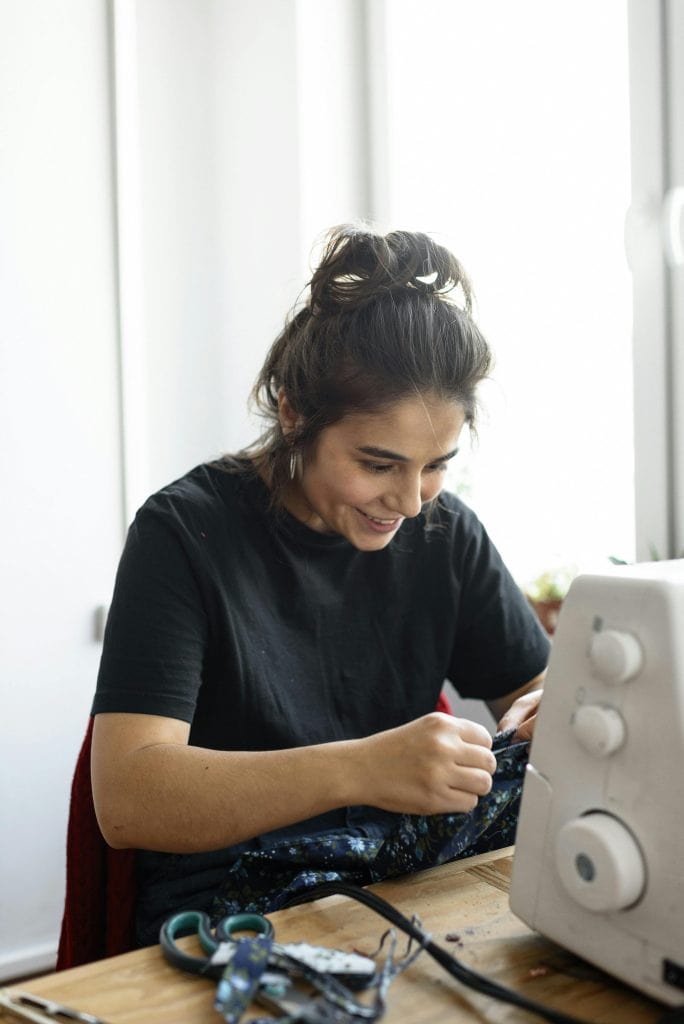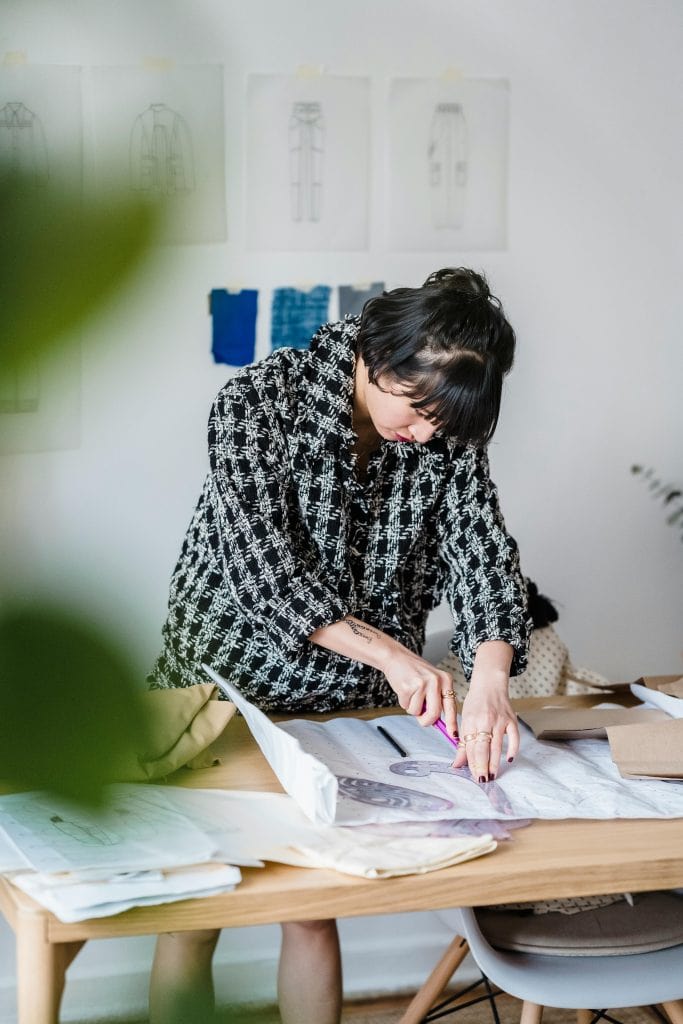Sewing is a craft that grows through repetition, not instant mastery.
The first stitches you place may feel uncertain, but each one strengthens your hands and your confidence.
What seems complicated at first (threading a bobbin, guiding fabric under the needle) becomes smoother with practice.
If you’ve sat at your machine and felt the learning curve stretch longer than expected, know that you’re not alone.
Every experienced sewer once repeated the same steps you are practicing today.
The difference between setting sewing aside and becoming skilled lies in how you respond when things feel slow.
With practical strategies and clear steps, you can keep momentum and enjoy the satisfaction of building this skill, piece by piece.
In this article, I’ll walk you through the common beginner hurdles and offer straightforward actions to move past them.
Understand the Learning Curve (What’s Normal at the Start)

The first stage of sewing is less about producing polished garments and more about building muscle memory.
When you sit down at your machine, your hands, eyes, and feet are learning how to work together. That coordination takes time. Instead of expecting perfect seams immediately, expect your first few projects to feel like training sessions – because they are.
Practice Drills to Build Control
A helpful practice is to set aside a “practice cloth” – a plain cotton square that you use only for exercises. Keep it near your machine and run through a few drills before you begin any project:
- Straight stitch lines: Draw lines on the fabric with chalk or a washable marker, then practice stitching directly on those lines. This trains hand control and pedal consistency.
- Corners: Draw an L-shape and practice pivoting with the needle down to turn fabric cleanly.
- Curves: Sketch a gentle curve and follow it with your stitching. This builds control for hems, collars, and pockets.
These exercises may feel simple, but they give you confidence when you move on to real projects. Just as a musician practices scales before a performance, these drills help you build steady hands and smoother stitches.
Troubleshooting With a Checklist
Another part of the learning curve is troubleshooting. Threading issues, skipped stitches, or fabric bunching can appear often in the beginning. Create a checklist for yourself so you don’t waste time guessing:
- Is the machine threaded correctly (top thread and bobbin)?
- Is the presser foot lowered?
- Is the needle suited to the fabric (size 70/10 for lightweight cottons, 90/14 for denim, etc.)?
- Is the thread weight appropriate for the project?
Keeping this checklist visible at your sewing space helps you resolve common sewing mistakes you must avoid quickly instead of feeling stuck.
Lastly, adjust your expectations for time. A beginner hem or pillowcase may take two hours instead of thirty minutes. That is the stage where your brain is learning the order of steps. By the third or fourth project, those same steps will feel natural and take a fraction of the time.
The learning curve is not an obstacle – it’s your training ground.
4 Beginner Hurdles (and How to Handle Them)

Each of these challenges is simply part of training your hands and your eye for sewing.
Once you know how to respond, they no longer feel like barriers – they become signs that you’re actively learning.
1. Thread Tension Mysteries
Uneven stitches – loops on one side, puckers on the other – are often linked to tension. Before turning the dial, take these steps first:
- Re-thread completely. Even one missed guide can throw tension off. Remove both top and bobbin threads and start fresh.
- Check the bobbin. Ensure it’s wound evenly and placed in the case in the correct direction (refer to your machine manual).
- Use test fabric. Keep a scrap of the same fabric you’re sewing. Stitch a few inches and check both sides before sewing your project.
- Adjust in small steps. If re-threading doesn’t solve it, turn the tension dial only one number at a time, then test again.
Pro tip: Keep a notebook where you jot down the fabric, thread, and tension setting that worked. This becomes a personal guidebook as you experiment with new projects.
2. Uneven Seams
Crooked or wobbly seams are part of early sewing, but they can be steadied with the right aids:
- Seam guide tools. Place painter’s tape, washi tape, or a magnetic seam guide along your machine’s throat plate. This gives your fabric a physical edge to follow.
- Focus on the guide, not the needle. Keep your eye on the fabric edge against the guide. Watching the needle often leads to drifting.
- Practice speed control. Lightly rest your foot on the pedal and aim for slow, consistent pressure. Set aside five minutes to “drive straight lines” on fabric scraps daily – just like learning to keep a car steady.
Over time, straight seams become automatic because your hands and eyes learn the motion.
3. Pattern Confusion
Reading sewing patterns can feel like learning a new language.
To simplify:
- Highlight your size. Circle or highlight it across the entire pattern sheet before cutting. This prevents following the wrong line mid-cut.
- Do a “paper fitting.” Pin the tissue pattern pieces together roughly and hold them up to yourself or your mannequin. This helps you visualize the shape before fabric cutting.
- Use tracing paper. Instead of cutting the original, trace your size onto pattern paper. This keeps your master pattern intact and allows you to make adjustments freely.
- Read ahead. Scan the entire step you’re about to do (not just the sentence you’re on) so you don’t get caught off guard by what comes next.
4. Feeling Stuck Mid-Project
Projects often feel heavy in the middle, when enthusiasm dips and details pile up.
To stay on track:
- Break tasks into checkpoints. Write them down: cut fabric, pin seams, sew main seams, add finishing touches. Cross them off as you go.
- Use a timer. Set 20–25 minutes for focused sewing, then take a short break. This keeps energy fresh.
- Stop on a high note. End your session at a clear stopping place—like after finishing a seam—so you return to an easy re-start, not a problem to untangle.
- Reset your space. If momentum fades, tidy your sewing table and rethread the machine. A reset often clears mental clutter.
Shift How You Think While Sewing

Your mindset is a tool as important as sharp scissors or a well-oiled machine.
How you speak to yourself at the sewing table shapes your progress.
A beginner who says “I’m learning” will keep practicing, while one who says “I’m failing” may lose momentum.
Training yourself to choose the first statement builds resilience.
Keep a visible “firsts” list. Write down milestones as they happen – your first buttonhole, first zipper, first finished garment. Tape the list to your wall or pinboard near your sewing space. On days when your stitches look uneven, glance at that list. It reminds you that you’re moving forward.
Reframe mistakes as instructions. A crooked seam isn’t wasted – it shows you exactly where your hand wobbled. Instead of tossing it aside, examine it. Was the fabric pulling? Did you look at the needle instead of the seam guide? Each misstep leaves a clear note for your next try.
Celebrate small completions. Even pressing a freshly sewn seam flat is a win worth noticing. By pausing to appreciate these small steps, you train yourself to value process as much as finished products.
Use language that supports progress. Replace “I can’t” with “I haven’t yet.” This tiny change shifts sewing from a fixed barrier to an open path. Words build habits, and habits build skills.
A steady mindset makes the curve easier to climb. With the right perspective, you start to see progress everywhere – in each straight seam, each corrected error, and each project that leaves your machine more polished than the last.
5 Practical Habits That Build Confidence

Sewing skills grow fastest when you build small, repeatable habits into your routine.
Instead of long, overwhelming sessions, short and consistent practice creates steady improvement.
1. Practice in Short Sessions
Set a timer for 20–30 minutes. This amount of time is enough to sew a seam, practice stitches, or cut fabric without burning out.
Consistency matters more than marathon sessions.
2. Prepare Ahead of Time
Before you leave your sewing space, wind an extra bobbin, re-thread the needle, or lay out your fabric pieces.
The next time you sit down, you can begin immediately without setup slowing you down.
3. Work With Forgiving Materials
Choose medium-weight cottons or linens for early projects.
These fabrics feed smoothly through the machine, press crisply, and hold stitches well.
Avoid slippery satins or stretchy knits until you’re ready for more challenge.
4. Refresh Your Tools Regularly
Change your sewing needle every 8 hours of sewing time, or at the start of each new project.
A dull needle causes skipped stitches and fabric snags.
Keep extra packs of universal needles on hand in sizes 80/12 and 90/14.
5. Use a Scrap Bin as a Practice Station
Collect leftover fabric pieces in a basket.
Each time you start sewing, test your stitches on a scrap before touching your real project.
This quick habit helps you fine-tune tension and stitch length without risking mistakes on your work.
Build a Supportive Environment

The space where you sew influences how smoothly your projects go.
A comfortable, well-organized setup reduces stress and keeps you focused on the craft itself.
- Good lighting: Use natural daylight when possible, or add a daylight LED lamp above your sewing area.
- Comfortable seating: Sit so your elbows rest at 90 degrees; adjust with cushions or a footrest if needed.
- Organized tools: Keep scissors, seam ripper, pins, and chalk in a tray within arm’s reach.
- Stable surface: Use a sturdy table; add a folding table to support larger projects and prevent fabric drag.
- Positive atmosphere: Play calm music, podcasts, or audiobooks to make practice more enjoyable.
Stay Connected and Inspired
Community brings energy to your sewing journey, but the deepest motivation often comes from noticing your own growth. When you take time to recognize progress – no matter how small – you turn practice into momentum.
That’s where celebration becomes a tool for staying consistent.
- Join a sewing community: Look for local classes, Facebook groups, or Reddit’s r/sewing.
- Ask clear questions: Post one specific issue at a time (e.g., “Why is my zigzag stitch loose on knit fabric?”).
- Share progress photos: Document even unfinished projects to see growth over time.
- Follow inspiring makers: Subscribe to a few sewing blogs or YouTube channels that match your style.
- Exchange support: Offer encouragement to others in the community – it builds connection and motivation.
Celebrate and Keep Going

Progress in sewing is easiest to see when you make it visible.
Keep a dedicated bin or basket where you place every finished item, no matter how small. A stack of cloth napkins, a simple tote, or a practice pillow cover may not feel like much individually, but together they show the volume of work you’ve already put in.
This turns your pile of practice into proof of growth.
Take progress photos of every project. Use the same background (a table, cutting mat, or wall) so you can compare side by side. Over time, you’ll see seams straighten, topstitching sharpen, and overall finish improve.
These comparisons help you recognize how your skill is building.
Create a project log. In a notebook, write the date, project name, fabric type, needle size, and one thing you learned. For example: “May 12 – Apron, cotton, 80/12 needle, learned to pivot corners.”
This log becomes both a memory of your sewing journey and a personal reference for future projects.
Finish every sewing session with a “reset step.” Wind a bobbin, thread a fresh needle, or press the next fabric piece. That way, when you return, you start with an easy win instead of setup. This habit lowers resistance and keeps your momentum strong.
Keep Sewing Forward: Build Skills, Build Confidence
Sewing is learned by sewing – through small projects, repeated practice, and consistent habits that make your progress visible.
When challenges come, treat them as part of the process rather than barriers.
With the right mindset and a few clear systems, you’ll find yourself improving faster than you expected.
Keep your projects moving, celebrate the small wins, and remember that every experienced sewer began exactly where you are today.
What’s the one sewing hurdle you’re working on right now? Comment down below – I’d love to hear and help encourage your journey.
FAQs
How do I choose the right needle for my fabric?
Match the needle to the fabric weight: size 70/10 for lightweight cottons and silks, size 80/12 for quilting cottons, and size 90/14 for denim or canvas. Changing your needle regularly also prevents skipped stitches.
What’s the easiest first project to build confidence?
Start with a pillowcase or cloth napkins. These use straight seams only, give you plenty of practice with measuring and pressing, and provide a finished item you can use right away.
How can I stop fabric from shifting while I sew?
Use more pins or switch to clips for thicker fabrics. You can also lengthen your stitch slightly (2.5–3 mm) so the fabric feeds evenly. A walking foot is another helpful tool for tricky layers.
How do I know if my machine needs servicing?
If your machine makes unusual noises, skips stitches even with a new needle, or struggles to feed fabric, it may need a tune-up. Regular servicing once a year keeps it running smoothly, especially if you sew often.
How do I store my projects if I can’t finish them in one sitting?
Keep an airtight container or project bag nearby. Place your cut pieces, pattern, and notes inside. Label with the project name and date so you can pick up exactly where you left off without confusion.

